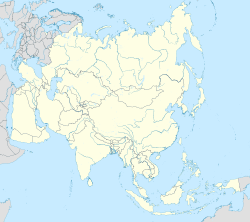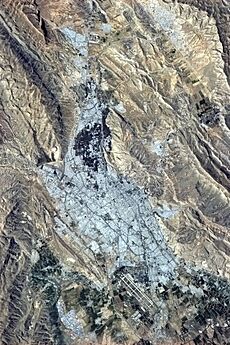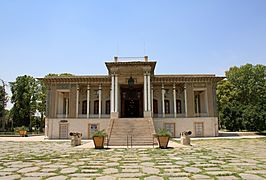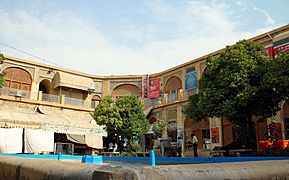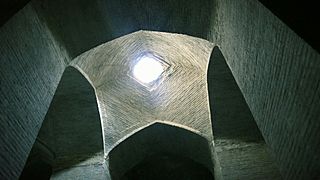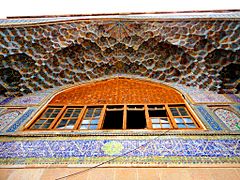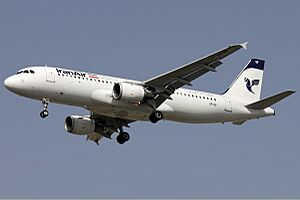Shiraz facts for kids
Quick facts for kids
Shiraz
Persian: شیراز
|
|||
|---|---|---|---|
| Shiraz | |||
|
Clockwise from top: skyline of Shiraz; Tomb of Saadi; Shāh Chérāgh; Nasir-ol-Molk Mosque; Shiraz modern skyline; Eram Garden; Karim Khan Citadel; and Tomb of Hafez
|
|||
|
|||
| Nickname(s):
City of Gardens
|
|||
| Country | Iran | ||
| Province | Fars | ||
| County | Shiraz | ||
| District | Central | ||
| Government | |||
| • Type | City Council | ||
| Area | |||
| • City | 240 km2 (86.487 sq mi) | ||
| • Land | 240 km2 (86.487 sq mi) | ||
| • Water | 0 km2 (0 sq mi) 0% | ||
| Elevation | 1,500 m (5,200 ft) | ||
| Population
(2016 census)
|
|||
| • Density | 6,670/km2 (18,600/sq mi) | ||
| • Urban | 1,565,572 | ||
| • Metro | 1,800,000 | ||
| • Population rank | 5th (Iran) | ||
| Time zone | UTC+03:30 (IRST) | ||
| Area code(s) | 071 | ||
| Routes | |||
| License plate | 63, 83, 93 | ||
Shiraz (Persian: شیراز) is a large and important city in Iran. It is the fifth-biggest city in the country. Shiraz is the capital of Fars province, which was once known as Pars or Persis.
In 2016, about 1.5 million people lived in Shiraz. If you include the nearby area of Sadra, the population was almost 1.8 million. By 2021, the city's population grew to nearly 2 million people.
Shiraz is in southwestern Iran, next to a seasonal river called rudkhaneye khoshk (dry river). The city was founded a long time ago, in the early Islamic period. It has a mild climate and has been a major trading hub for over a thousand years.
The name Tiraziš was found on ancient clay tablets from 2000 BCE, which is the earliest mention of the city. Shiraz became important under the Saffarid and Buyid rulers in the 9th and 10th-11th centuries.
By the 1200s, Shiraz was a leading center for arts and learning. This was thanks to its rulers and many talented Persian scholars and artists. Two very famous Iranian poets, Hafez and Saadi, were from Shiraz. Their tombs are still in the city today.
Shiraz is a top tourist city in Iran. It is known as the city of poets, literature, and flowers. Many Iranians also call it the "city of gardens" because of its beautiful gardens and fruit trees, like Eram Garden. Tourists from all over the world visit Shiraz every year.
Historically, Shiraz has been home to large Jewish and Christian communities. The city is famous for its crafts, including inlaid mosaic work, silverware, and beautiful carpets and kilim rugs. Key industries in Shiraz include making cement, sugar, textiles, wood products, and metalwork. Shiraz also has a big oil refinery. It is a major center for Iran's electronic industries, with more than half of Iran's electronic investments located here. The city also has Iran's first solar power plant and a new wind turbine.
Contents
- The Name of Shiraz
- Shiraz Through History
- People of Shiraz
- Shiraz Geography and Climate
- Shiraz Economy
- Shiraz Culture
- Visiting Shiraz: Top Tourist Spots
- Learning and Education in Shiraz
- Getting Around Shiraz
- Sports in Shiraz
- Famous People from Shiraz
- Shiraz and Other Cities: International Connections
- Images for kids
- See also
The Name of Shiraz
The first time the city's name appeared was on Elamite clay tablets. These tablets date back to 2000 BCE. They were found in 1970 during digging for a brick factory. The tablets mention a city called Tiraziš.
Over time, this name changed. It became Shirājiš in Old Persian. Then, through natural language changes, it became the modern Persian name Shirāz. The name Shiraz also shows up on old seals from a 2nd-century CE Sassanid ruin. Some local writers believe the name Shiraz comes from a son of Tahmuras, a king from ancient Persian stories.
Shiraz Through History
Early Beginnings of Shiraz
Even though there aren't many old records, some discoveries show that people lived in or near Shiraz very early. This might have been as far back as 600 BCE. Remains from the Achaemenid and Sasanian times have been found. These include carvings and ruins of old forts.
One important fort, Qasr-e Abu Nasr, had clay seals that mentioned "Shiraz." This suggests that the name "Shiraz" has been around since the Elamite period. It likely referred to a settlement at the site of Qasr-e Abu Nasr.
Historians have different ideas about how important ancient Shiraz was. Some think it was just a small stop along a path. Others believe it was one of the most important settlements in the area. This is because it is mentioned often in old records about workers.
Shiraz in the Islamic Era
Shiraz was either founded or rebuilt in 693 CE. This was done by Muhammad ibn Yusuf al-Thaqafi, whose brother was a powerful leader. The Arab Muslim army had taken over the Fars region earlier. They wanted to create a new cultural and administrative center in Shiraz. This was to be a rival to Istakhr, the old Sasanian capital.
At first, Shiraz was not very important. It was overshadowed by Istakhr. But as more people in Fars became Muslim and Istakhr declined, Shiraz grew. It became the main center of Fars.
In the late 800s, the Saffarid dynasty made Shiraz their capital. This kingdom covered most of modern-day Iran. In 894, the Saffarid ruler Amr built the city's first main mosque, now called the Atigh Jame' Mosque.
Later, the Buyid dynasty took control in 933. Under their rule, Shiraz became the largest and most successful city in Fars. It was a major economic and cultural hub. A powerful Buyid ruler, 'Adud al-Dawla, built a huge library, a hospital, mosques, and markets. He also built palaces and gardens in the city.
Under the Buyids, Shiraz was a wealthy city. It traded many farm products like grapes, linen, and cotton. It was also a market for expensive rugs and paintings. Shiraz was known for its learning and was called Dar al-'Elm, the House of Knowledge. Famous poets like Sa'di and Hafiz were born here. This is why Shiraz is sometimes called "The Athens of Iran."
The city was lucky during the Mongol invasions. Its ruler offered gifts and agreed to obey Genghis Khan. This saved Shiraz from being destroyed. Later, Tamerlane also spared the city in 1382 for the same reason.
Shiraz in Later Centuries
In 1504, the Safavid dynasty took over Shiraz. It remained an important provincial capital. Many beautiful palaces and buildings were constructed during this time. These were similar to those in Isfahan, the Safavid capital.
After the Safavids fell, Shiraz faced hard times. It was attacked and its population dropped. Many historical buildings were damaged.
But Shiraz became prosperous again under Karim Khan Zand. He made it his capital in 1762. He hired over 12,000 workers to build a royal area with a fortress, government buildings, a mosque, and a beautiful covered market. He also rebuilt the city walls.
However, after Karim Khan's death, his family lost power. Agha Mohammad Khan, who started the Qajar dynasty, destroyed Shiraz's defenses. He moved the national capital to Tehran. Even so, Shiraz remained a busy trading city. Many of its famous gardens and buildings were built during this time.
Shiraz is also important to the Baháʼí Faith. The Báb, one of its founders, was born here. In 1844, he announced his mission in Shiraz. This makes Shiraz a holy city for Baháʼís.
During the Pahlavi dynasty, Shiraz gained attention again. Important landmarks, like the tombs of poets Sa'di and Hafiz, were built or restored. Today, Shiraz is an administrative center. Its population has grown a lot since the Iranian Revolution.
Modern Shiraz Today
The city is actively working to restore and rebuild its historic sites. Recent projects include fully restoring the Arg of Karim Khan and the Vakil Bath. There is also a plan to protect the old city areas.
Other important projects include fixing up the Qur'an Gate and the tomb of poet Khwaju Kermani. Both are in the Allah-u-Akbar Gorge. The tombs of famous poets Hafiz and Saadi have also been restored and expanded. Many new construction projects are happening to make the city's infrastructure more modern.
People of Shiraz
Who Lives in Shiraz?
The majority of people in Shiraz are Persian. Most of the population follows the Muslim faith. Shiraz also used to have a large Jewish community. Many of them moved to the United States and Israel in the late 1900s.
Shiraz is one of the few Iranian cities with a noticeable Jewish population. It has more than one active synagogue. Shiraz also has a significant Baháʼí Faith population. It is the largest in the country after Tehran. There are two churches in Shiraz that are still used today. One is Armenian and the other is Anglican.
How Many People Live Here?
| Historical population | ||
|---|---|---|
| Year | Pop. | ±% p.a. |
| 1986 | 848,289 | — |
| 1991 | 965,117 | +2.61% |
| 1996 | 1,053,025 | +1.76% |
| 2006 | 1,227,331 | +1.54% |
| 2011 | 1,460,665 | +3.54% |
| 2016 | 1,565,572 | +1.40% |
| source: | ||
In 2006, Shiraz had about 1.2 million people. By 2011, this number grew to about 1.46 million. The 2016 census showed the population was 1,565,572 people.
Shiraz Geography and Climate
Where is Shiraz Located?
Shiraz is the capital of Fars province. It is located in southern Iran, in the northwest of Fars province. The city is built on a green plain at the foot of the Zagros Mountains. It is about 1,500 meters (5,200 feet) above sea level. Shiraz is about 800 kilometers (500 miles) south of Tehran.
A seasonal river, called Dry River, flows through the northern part of the city. It then goes into Maharloo Lake. In the past, the area had a large forest of oak trees.
Beautiful Gardens of Shiraz
Shiraz is famous for its many gardens. Some of these gardens are very old, like the Eram Garden and the Afif Abad Garden. As the city grows, there is a risk that some gardens might be lost to new buildings. The city is trying to protect these gardens, but some illegal building still threatens them.
Shiraz Weather and Climate
Shiraz has clear seasons. Its climate is generally semi-arid. Summers are hot, with July temperatures often reaching 38.7°C (101.7°F). Winters are cool, and temperatures can drop below freezing in January.
About 320 mm (12.6 inches) of rain falls each year. Most of this rain comes in the winter months. Sometimes, a lot of rain can fall in just one month. For example, in January 1965 and December 2004, heavy rains caused floods. In March 2019, flash floods from heavy rains led to 19 deaths and over 200 injuries.
The highest temperature ever recorded in Shiraz was 43.4°C (110.1°F) on July 3, 2022. The lowest was -14.0°C (6.8°F) on January 5, 1973.
| Climate data for Shiraz, altitude: 1488 m (1991–2020 normals, extremes 1951-2020) | |||||||||||||
|---|---|---|---|---|---|---|---|---|---|---|---|---|---|
| Month | Jan | Feb | Mar | Apr | May | Jun | Jul | Aug | Sep | Oct | Nov | Dec | Year |
| Record high °C (°F) | 23.4 (74.1) |
25.6 (78.1) |
30.8 (87.4) |
34.0 (93.2) |
39.0 (102.2) |
42.8 (109.0) |
43.5 (110.3) |
42.8 (109.0) |
39.2 (102.6) |
35.0 (95.0) |
28.6 (83.5) |
24.2 (75.6) |
43.5 (110.3) |
| Mean daily maximum °C (°F) | 12.9 (55.2) |
15.6 (60.1) |
19.6 (67.3) |
25.0 (77.0) |
31.3 (88.3) |
36.7 (98.1) |
38.7 (101.7) |
37.7 (99.9) |
34.3 (93.7) |
28.4 (83.1) |
20.3 (68.5) |
15.3 (59.5) |
26.3 (79.4) |
| Daily mean °C (°F) | 6.1 (43.0) |
8.7 (47.7) |
12.4 (54.3) |
17.5 (63.5) |
23.6 (74.5) |
28.6 (83.5) |
30.8 (87.4) |
29.5 (85.1) |
25.5 (77.9) |
19.6 (67.3) |
12.3 (54.1) |
7.8 (46.0) |
18.5 (65.4) |
| Mean daily minimum °C (°F) | −0.2 (31.6) |
1.9 (35.4) |
4.9 (40.8) |
9.3 (48.7) |
14.0 (57.2) |
17.8 (64.0) |
20.6 (69.1) |
19.4 (66.9) |
15.1 (59.2) |
10.0 (50.0) |
4.6 (40.3) |
1.1 (34.0) |
9.9 (49.8) |
| Record low °C (°F) | −14.0 (6.8) |
−8.1 (17.4) |
−4.3 (24.3) |
−2.0 (28.4) |
3.0 (37.4) |
8.1 (46.6) |
14.0 (57.2) |
12.0 (53.6) |
1.0 (33.8) |
1.6 (34.9) |
−8.0 (17.6) |
−11.0 (12.2) |
−14.0 (6.8) |
| Average precipitation mm (inches) | 79.0 (3.11) |
53.6 (2.11) |
52.0 (2.05) |
26.0 (1.02) |
5.8 (0.23) |
0.2 (0.01) |
0.4 (0.02) |
1.4 (0.06) |
0.0 (0.0) |
4.0 (0.16) |
37.8 (1.49) |
64.1 (2.52) |
324.3 (12.78) |
| Average precipitation days (≥ 1.0 mm) | 6.3 | 5.4 | 5.1 | 3.3 | 1.3 | 0.1 | 0.2 | 0.2 | 0 | 0.8 | 3.3 | 4.7 | 30.7 |
| Average rainy days | 9.5 | 9.2 | 9.2 | 5.9 | 1.9 | 0.3 | 0.5 | 0.3 | 0.1 | 1.3 | 5.8 | 7.6 | 51.6 |
| Average snowy days | 1.5 | 0.6 | 0.0 | 0.0 | 0.0 | 0.0 | 0.0 | 0.0 | 0.0 | 0.0 | 0.0 | 0.6 | 2.7 |
| Average relative humidity (%) | 59 | 52 | 46 | 41 | 28 | 20 | 21 | 23 | 25 | 32 | 49 | 58 | 38 |
| Average dew point °C (°F) | −2.1 (28.2) |
−1.7 (28.9) |
−0.2 (31.6) |
2.5 (36.5) |
2.2 (36.0) |
1.7 (35.1) |
4.9 (40.8) |
4.7 (40.5) |
2.4 (36.3) |
0.9 (33.6) |
0.4 (32.7) |
−0.8 (30.6) |
1.2 (34.2) |
| Mean monthly sunshine hours | 218 | 214 | 248 | 260 | 327 | 353 | 340 | 339 | 310 | 295 | 233 | 226 | 3,363 |
| Source 1: NOAA NCEI | |||||||||||||
| Source 2: Iran Meteorological Organization (records),(days with snow), | |||||||||||||
Neighborhoods of Shiraz
Shiraz has many different neighborhoods, including:
- Zargari
- Abivardi
- Farhang Shahr
- Qasrodasht
- Koshan
- Kuye Zahra
- Ma'ali Abad
- Molla Sadra
- Shahcheragh
- Riyasati Avval
- Riyasati Dovvom
- Shahrak-e-Golestan
- Shahrak-e-Sadra
- Tachara
- Zerehi
- Kolbeh Saadi
- Podonak
- Payegah
- Eram
- Bagh-e Nari (Narvan)
- Siahatgar BLVD
- Abiari Ave
- Artesh square (Army Square)
- Bridgestone
- Babakuhi
- Kuye Jamaran(siman)
- Baskul Nader
- Talkhedash
- Kaftarak
- Sare Dozak
- Chamran
- Sange Siah
- Amir Kabir Blvd
- Modares
- Dinakan
- Darvazeh Kazeron
- Darvaze Isfahan
- Bagh Safa
- Atlasi
- Derki
- See also: Saadi Street
Shiraz Economy
Shiraz is the main economic hub of southern Iran. In the late 1800s, its economy changed a lot. The opening of the Suez Canal in 1869 made it easier to bring cheap European goods into southern Iran. Farmers started growing more crops like opium poppy, tobacco, and cotton to sell. Many of these crops passed through Shiraz on their way to the Persian Gulf.
Shiraz's economy relies on its local products. These include grapes, citrus fruits, cotton, and rice. Key industries are making cement, sugar, textiles, wood products, and metalwork. Shiraz also has a large oil refinery. It is a major center for Iran's electronic industries. More than half of Iran's electronic investments are in Shiraz.
The Shiraz Special Economic Zone (SEEZ) was created in 2000. Its goal is to boost the making of electronics and communication devices.
Shiraz is a big shopping destination in Iran and the Middle East. It has over 25 malls and 10 traditional markets called bazaars. The Persian Gulf Complex is one of the largest malls in the world by the number of shops.
Shiraz Culture
Shiraz is known as the city of poets, gardens, and flowers. Gardens are a very important part of Iranian culture. Shiraz has many old gardens, like the Eram garden and the Afif Abad garden.
Shiraz is proud to be the home of Hafiz Shirazi. It is a center for Iranian culture and has produced many famous poets. Saadi, a poet from the 12th and 13th centuries, was born in Shiraz. He left to study in Baghdad and returned as an older man. Shiraz was peaceful then, and Saadi was highly respected. He spent the rest of his life in Shiraz.
Hafez, another famous poet and mystic, was also born in Shiraz. Many scientists also come from Shiraz. Qutb al-Din al-Shirazi, a 13th-century astronomer and scientist, was from Shiraz. He even discussed the idea of the Earth going around the Sun.
Visiting Shiraz: Top Tourist Spots
Shiraz is a very important place for tourism in Iran. Its cultural heritage is known around the world.
-
Nasirul-Molk Mosque, known for its colorful tiles.
-
Afif-Abad Garden (Arms Museum), a garden with a museum.
-
Eram Garden, a famous Persian garden.
- Tombs of Poets: You can visit the tombs of famous poets like Hafiz, Saadi, and Khaju e Kermani. Khaju e Kermani's tomb is inside a mountain near the city's Qur'an Gate. Other tombs include Shah Shoja' and the Haft Tanan mausoleum, where seven Sufi mystics are buried. The Tomb of Baba Kuhi is on a mountain overlooking the city. The tomb of Karim Khan Zand is at the Pars Museum of Shiraz.
- Mosques: The oldest mosque is Atigh Jame' Mosque. Other important mosques are Vakil Mosque and Nasir al-Mulk mosque.
- Citadel and Bazaar: The Arg of Karim Khan (a fortress) is next to the Vakil Bazaar (a market) and Vakil Bath in the city center.
- Qur'an Gate: This gate is the entrance to Shiraz. It is located near the Allah-o-Akbar Gorge, between two mountains. The gate once held two handwritten Qur'ans, which are now in the Pars Museum.
- Eram Garden: The Eram Garden (Bagh-e Eram) is a beautiful place to visit. It has many different plants and a lovely mansion.
- Margoon Waterfall: This beautiful waterfall is in the Fars Province of Iran. It is near the city of Sepidan.
- Shapur Cave: This cave is in the Zagros Mountains in southern Iran. It is about 6 kilometers (3.7 miles) from the city of Bishapur.
- Sangtarashan Cave: This cave is located in Jahrom, in southern Iran.
- Palace of Ardashir: Also known as the Atash-kadeh, this castle was built in 224 AD by King Ardashir I. It is located near the ancient city of Gor.
- Pooladkaf Ski Resort: This is a ski resort in southern Iran. It opened in 2002.
- Sarvestan Palace: This is a building from the Sassanid era. It is in the Iranian city of Sarvestan.
- Qal'eh Dokhtar: This castle was built by Ardashir I in 209 AD. It is in present-day Fars, Iran.
- Maharloo Lake: Maharloo is a seasonal salt lake about an hour from Shiraz. It often looks pink because of tiny red organisms in the water.
-
Plain of Fritillaria imperialis, a field of beautiful flowers in Sepidan County.
-
Sassanid Palace at Sarvestan, an ancient building.
Learning and Education in Shiraz
Shiraz has a lively academic community. The Shiraz University of Medical Sciences was the first university in Shiraz. It was founded in 1946. Even older is the Khan Theological School, which dates back to 1627. It has about 600 students.
Today, Shiraz University is the biggest university in the province. It is also one of Iran's best academic centers. Other major universities in or near Shiraz include the Islamic Azad University of Shiraz, Shiraz University of Technology, and Shiraz University of Applied Science and Technology.
The Shiraz Regional Library of Science and Technology is a public library for the province. The Virtual University of Shiraz is also part of Shiraz University.
Getting Around Shiraz
By Air: Shiraz International Airport
Shiraz International Airport is the largest airport in southern Iran. It serves as a major travel hub for the region.
By Metro: Shiraz Subway System
Construction of a metro system began in 2001. The plan is to build six lines. The first line is 22.4 kilometers (13.9 miles) long. The second line will be about 14 kilometers (8.7 miles) long.
The first three lines will have 32 underground stations and six above-ground stations. One special station will connect to the railway station. The first line opened in October 2014.
By Bus: Public Transportation
The Shiraz bus organization started in 1966. It began with 10 buses and a staff of drivers and ticket sellers. The company launched three bus lines, which were popular with people. Today, Shiraz has 71 bus lines, making it easy to travel around the city.
By Rail: Train Connections
Shiraz is connected to the rest of Iran's railway network. Trains arrive and leave from Shiraz railway station. This is Iran's largest railway station by surface area.
By Road: City Streets and Highways
There are about 700,000 cars in Shiraz. The city is served by important roads like Road 63 and Road 93.
Sports in Shiraz
Football (soccer) is the most popular sport in Shiraz. The city has several football teams. The main sports venue in Shiraz is Hafezieh Stadium. It can hold up to 20,000 people. Shiraz also has another stadium called Pars Stadium. This stadium was finished in 2017 and can host up to 50,000 spectators.
Famous People from Shiraz
Shiraz has been home to many important people throughout history.
Religious Leaders and Thinkers
- Mu'ayyad fi'l-Din al-Shirazi: A very knowledgeable scholar, poet, and scientist from the 11th century.
- Mulla Sadra: An Islamic philosopher who led a cultural rebirth in Iran in the 1600s.
- Siyyid 'Alí Muḥammad Shírází: The founder of Bábism and a key figure in the Baháʼí Faith.
Scientists and Academics
- Qutb al-Din al-Shirazi: A 13th-century Iranian poet and scholar.
- Sibawayh: A famous linguist who studied the Arabic language.
- Firouz Naderi: A scientist who worked as the Director for Solar System Exploration at NASA's Jet Propulsion Laboratory (JPL).
- Gholam A. Peyman: The inventor of LASIK eye surgery.
- Ali Asghar Khodadoust: A professor of Ophthalmology (eye medicine) who developed a special surgical method.
- M. Hashem Pesaran: An Iranian economist and professor at the University of Cambridge.
- Farshid Delshad: A linguist and translator.
- Reza Negarestani: A philosopher and writer.
Poets and Writers
- Saadi: A famous poet from the medieval period.
- Hafez: A celebrated poet.
- Shahriyar Mandanipour: A modern writer.
- Simin Daneshvar: A novelist and author.
- Mehdi Hamidi Shirazi: A contemporary poet.
- Fereidoon Tavallali: A contemporary poet and intellectual.
- Abdolali Dastgheib: A literary critic and writer.
Other Artists
- Bahram Dabiri: A painter and artist.
- Shirazeh Houshiary: An artist born in Shiraz who lives in London.
- Arsi Nami: An award-winning singer and songwriter.
- Ebrahim Golestan: A writer and filmmaker.
- Gholamhossein Saber: An artist.
- Tooji: A singer, model, and TV host who represented Norway in the Eurovision Song Contest.
- Bahar Pars: An actress.
Other Notable People
- Mohammad Namazi: A generous person who founded the Namazi hospital in Shiraz. This hospital later helped start the Shiraz University of Medical Sciences.
- Mohammad Bahmanbeigi: An activist who helped set up education for tribes in Iran.
- Eghbal Hamidy: A designer of Formula One cars for several racing teams.
- Omid Norouzi: An Iranian wrestler who won world and Olympic championships.
- Abbas Dowran: A skilled fighter jet pilot who died during the Iran–Iraq War.
Shiraz and Other Cities: International Connections
Twin Towns and Sister Cities
Shiraz has special connections with other cities around the world, called "twin towns" or "sister cities." These connections help promote cultural exchange and friendship.
Partner Cities
Images for kids
See also
 In Spanish: Shiraz para niños
In Spanish: Shiraz para niños














